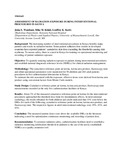Assessment Of Radiation Exposure During Interventional Procedures In Kenya

View/
Date
2013-06Author
Wambani, Jeska S
Kidali, Mike M
Korir, Geoffrey K
Type
PresentationLanguage
enMetadata
Show full item recordAbstract
Background: The increasing number of interventional procedures in Kenya
benefits many patients and results in radiation burden. Some patient radiation
dose studies in developed countries have reported patients’ cumulative skin
dose exceeding the thresholds causing skin erythema. To ensure safety, there is
a need in Kenya for training on operational monitoring and recording of patient
radiation exposure.
Objective: To quantify ionizing radiation exposure to patient during interventional
procedures and establish national diagnostic reference levels (NDRLs) for
clinical radiation management.
Methodology: The cumulative reference point air kerma, kerma area product,
fluoroscopy time and other operational parameters were monitored for 50
children and 261 adult patients procedures in five catheterization laboratories in
Kenya.
To estimate the risk associated with the exposure, effective doses were derived
from kerma area product using conversion factors from Monte Carlo models.
Study Design: Cumulative reference point air kerma, kerma area product,
fluoroscopy time measurements recorded at the only five catheterization facilities
in Kenya.
Results: About 3% of the measured cumulative reference point air kerma for the
interventional procedures approached the threshold dose limit for deterministic
effects. In interventional cardiology, the results obtained for both children and
adults indicated that 33% were below the DRLs for each of the following;
cumulative reference point air kerma, kerma area product, and fluoroscopy time.
The respective figures in adult interventional radiology were 29%, 43%, and
43%.
Conclusion: The measured patient doses were above the available DRLs in the
literature indicating a need for optimization continuous monitoring and recording
of patient dose.
Recommendation: To promote radiation safety, catheterization facilities need
to establish a radiation monitoring notification threshold in addition to the use of
the newly established NDRLs as a quality assurance tool.
Citation
Wambani, Jeska S., Kidali, Mike M., Korir, Geoffrey K.;Assessment Of Radiation Exposure During Interventional Procedures In Kenya ;presentation at the 2nd International Scientific Conference, Chs And Knh, 19th - 21st June 2013.Publisher
University of Nairobi College of Health Sciences
